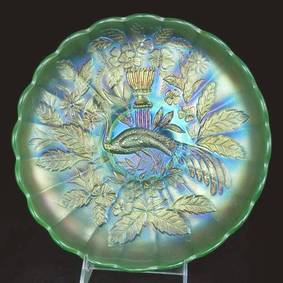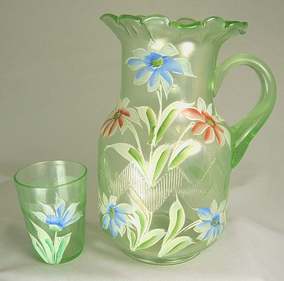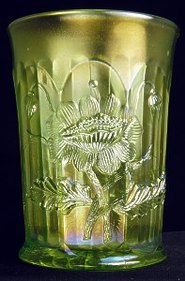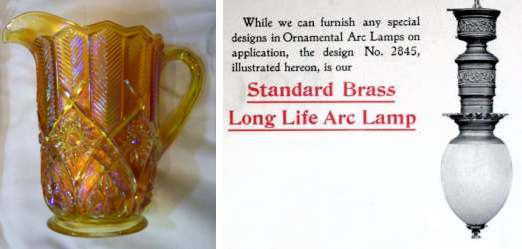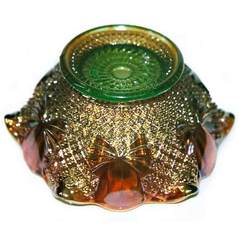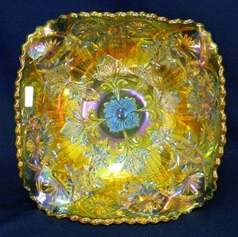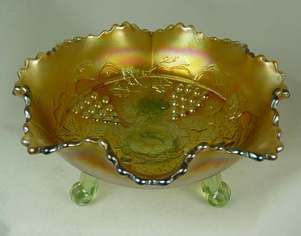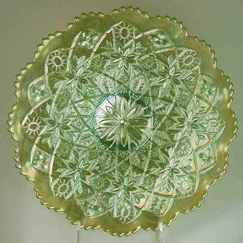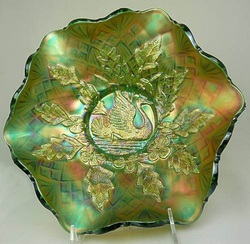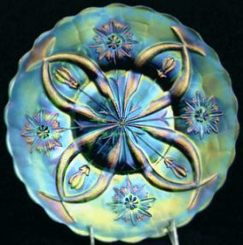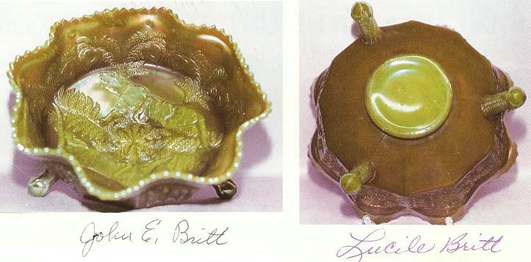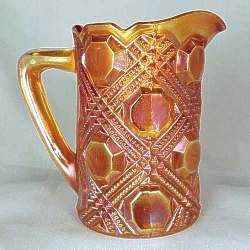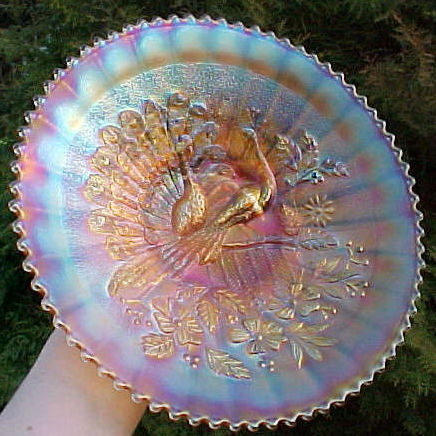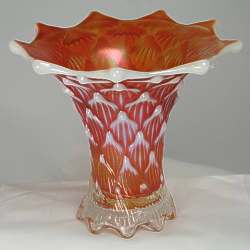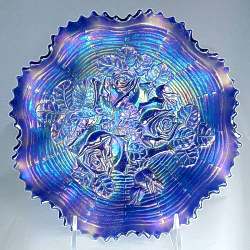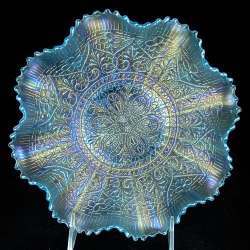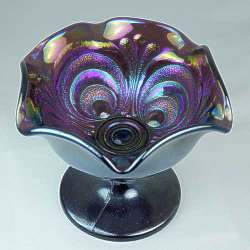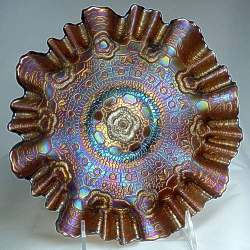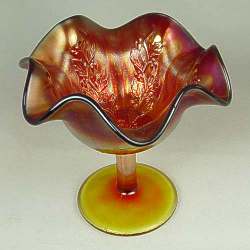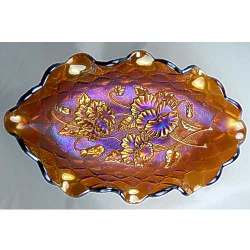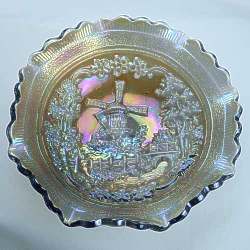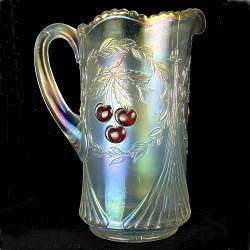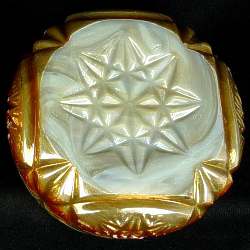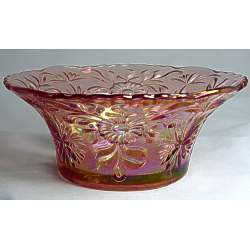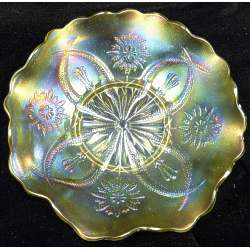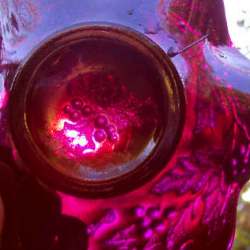Carnival Glass Colours - Green
The two colourants often used to create green glass were iron and chrome, as well as uranium for the yellow/yellow-green colour that glows brightly under ultra violet (UV) light, which is known to Carnival Glass collectors as vaseline.
The greens, from the lightest up to darkest:
Ice green – pale green – also known with touch of opal (ice green opal).
Florentine Green – this was Fenton’s answer to ice green, can be stretchy and may have a gentle UV glow. Fenton themselves used the term Florentine Green in ads in 1921 to describe green Stretch glass, and the description is now used by Carnival and Stretch glass collectors alike.
The greens, from the lightest up to darkest:
Ice green – pale green – also known with touch of opal (ice green opal).
Florentine Green – this was Fenton’s answer to ice green, can be stretchy and may have a gentle UV glow. Fenton themselves used the term Florentine Green in ads in 1921 to describe green Stretch glass, and the description is now used by Carnival and Stretch glass collectors alike.
Afterglow green – a pale green Dugan–Diamond colour from the 1920s and very early 1930s. No UV reaction. Usually has a marigold iridescence.
Lime Green - at first glance it may be perceived as being similar to vaseline, as it is a light, limey shade. However, lime green is not reactive to UV light. Lime green sometimes can have a frosty iridescence (lime ice green) and thus may also be perceived as being similar to ice green. Lime green can also be found with either a pastel or a marigold iridescence.
Lime green opal – lime green with a white opal edge is also known.
Vaseline – varies from a yellow colour to a limey yellow-green. It has uranium (as uranium dioxide) as its colourant which is reactive to ultra-violet (UV) light. The iridescence can be marigold or delicate pastel. To be true vaseline it must have a vivid UV glow - a vivid yellow-green, transparent fluorescent effect under a UV light. Other chemicals in the glass batch may also react to UV light but in different ways, giving a different colour effect. For example, chromium (which is used sometimes to colour glass shades of blue) may also glow, but it is more of a translucent greenish glow, not the “in your face” vivid and transparent yellow-green from uranium. Also, some clear/flint/marigold glass will have a dull glow caused by manganese in the batch used as a decoloriser i.e. to neutralise the green from iron impurities.
|
A Major Discovery about Vaseline: it was thought that it was the effect of UV rays from the setting sun that attracted people to Vaseline glass. It is a delightful effect, but it is nothing like the fluorescent WOW effect of a black (UV) light. In a major piece of research, we discovered that in the late 1800s / early 1900s, the Victorians knew all about the vivid fluorescence of Vaseline glass. They had Arc Lamps - their own version of UV black lights!
We found the proof in an 1897 newspaper article. An eye witness account tells us how uranium glass (Vaseline) produced a magnificent green fluorescence under the electric arc lamp. The arc lamp was the first commercially successful electric light, emitting a super-bright purplish-white light, which was in fact UV light. |
The report explained the popularity of the glass was due to the fascinating and different effects it produced under various lighting. It was a big selling point!
Read all about our amazing discovery: Vaseline Glass - The Magic of the Arc Light.
See below for the varying shades of vaseline base glass colour. Collectors of other types of glass insist that vaseline glass has to be yellow, and the yellow-green or green glass that glows under UV light is called uranium glass. Vaseline Opal is also known.
Read all about our amazing discovery: Vaseline Glass - The Magic of the Arc Light.
See below for the varying shades of vaseline base glass colour. Collectors of other types of glass insist that vaseline glass has to be yellow, and the yellow-green or green glass that glows under UV light is called uranium glass. Vaseline Opal is also known.
Citrine – a deeper yellow-green than vaseline, but not quite olive green. No UV glow.
Helios – a mid green that sometimes has a faint UV glow. Its main characteristic is a distinctive silver-gold metallic looking iridescence.
(Standard) Green - the mid range green colour that represents the bulk of green Carnival Glass production.
|
Alaskan – a term used by collectors specifically to describe a green base glass with a (sometimes partial) marigold iridescence made by Northwood. We believe that it was originally a wholesaler’s promotional sales description. We have a comprehensive article on this topic, here: The Great Alaskan Mystery Emerald – mid green base glass with a blue green, vibrant iridescent effect. Much controversy though, see the Controversies section. Nile green – opaque yellow-green. On the right is a Fenton Panther master bowl in this unique colour, a highlight of the 1991 John & Lucile Britt auction. Olive and Russet – slightly yellow / brown. Teal – see section on blue. |
Click any image to look at more colours
